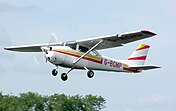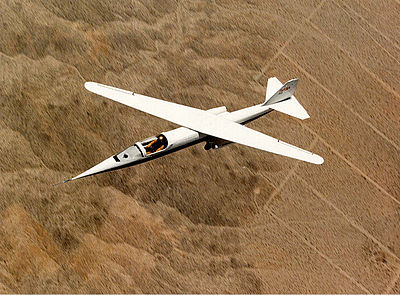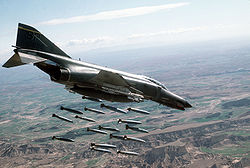| Main page | Categories & Main topics |
|
Tasks and Projects |
The Aviation Portal

Aviation includes the activities surrounding mechanical flight and the aircraft industry. Aircraft includes fixed-wing and rotary-wing types, morphable wings, wing-less lifting bodies, as well as lighter-than-air craft such as hot air balloons and airships.
Aviation began in the 18th century with the development of the hot air balloon, an apparatus capable of atmospheric displacement through buoyancy. Some of the most significant advancements in aviation technology came with the controlled gliding flying of Otto Lilienthal in 1896; then a large step in significance came with the construction of the first powered airplane by the Wright brothers in the early 1900s. Since that time, aviation has been technologically revolutionized by the introduction of the jet which permitted a major form of transport throughout the world. (Full article...)
Selected article

Selected image

Did you know
...that in the late 1940s the USAF Northrop YB-49 set both an unofficial endurance record and a transcontinental speed record? ...that passengers aboard JetBlue Airways Flight 292 were able to watch their own malfunctioning aircraft circle Los Angeles International Airport on the satellite television screens at each seat until the flight crew disabled the system in preparation for the aircraft's successful emergency landing? ... that former USAF officer David P. Cooley who was the chief test pilot for the F-117 Nighthawk died in March 2009 while testing the F-22 Raptor?
General images -
In the news
- May 29: Austrian Airlines cancels Moscow-bound flight after Russia refuses a reroute outside Belarusian airspace
- August 8: Passenger flight crashes upon landing at Calicut airport in India
- June 4: Power firm helicopter strikes cables, crashes near Fairfield, California
- January 29: Former basketball player Kobe Bryant dies in helicopter crash, aged 41
- January 13: Iran admits downing Ukrainian jet, cites 'human error'
- January 10: Fire erupts in parking structure at Sola Airport, Norway
- October 27: US announces restrictions on flying to Cuba
- October 3: World War II era plane crashes in Connecticut, US, killing at least seven
- September 10: Nevada prop plane crash near Las Vegas leaves two dead, three injured
- August 6: French inventor Franky Zapata successfully crosses English Channel on jet-powered hoverboard
Related portals
Associated Wikimedia
The following Wikimedia Foundation sister projects provide more on this subject:
-
 Commons
Commons
Free media repository -
 Wikibooks
Wikibooks
Free textbooks and manuals -
 Wikidata
Wikidata
Free knowledge base -
 Wikinews
Wikinews
Free-content news -
 Wikiquote
Wikiquote
Collection of quotations -
 Wikisource
Wikisource
Free-content library -
 Wikiversity
Wikiversity
Free learning tools -
 Wikivoyage
Wikivoyage
Free travel guide -
 Wiktionary
Wiktionary
Dictionary and thesaurus
Selected biography
Elizabeth Muriel Gregory "Elsie" MacGill (27 March 1905 – 4 November 1980), known as the Queen of the Hurricanes, was the world's first female aircraft designer. She worked as an aeronautical engineer during the Second World War and did much to make Canada a powerhouse of airplane construction during her years at Canada Car and Foundry (CC&F) in Fort William, Ontario. After her work at CC&F she ran a successful consulting business. Between 1967–1970 she was a commissioner on the Royal Commission on the Status of Women in Canada, published in 1970.
Selected Aircraft

The McDonnell Douglas F-4 Phantom II is a two-seat, twin-engined, all-weather, long-range supersonic fighter-bomber originally developed for the U.S. Navy by McDonnell Aircraft. Proving highly adaptable, it became a major part of the air wings of the U.S. Navy, U.S. Marine Corps, and U.S. Air Force. It was used extensively by all three of these services during the Vietnam War, serving as the principal air superiority fighter for both the Navy and Air Force, as well as being important in the ground-attack and reconnaissance roles by the close of U.S. involvement in the war.
First entering service in 1960, the Phantom continued to form a major part of U.S. military air power throughout the 1970s and 1980s, being gradually replaced by more modern aircraft such as the F-15 Eagle and F-16 Fighting Falcon in the U.S. Air Force; the F-14 Tomcat and F/A-18 Hornet in the U.S. Navy; and the F/A-18 in the U.S. Marine Corps. It remained in use by the U.S. in the reconnaissance and Wild Weasel roles in the 1991 Gulf War, finally leaving service in 1996. The Phantom was also operated by the armed forces of 11 other nations. Israeli Phantoms saw extensive combat in several Arab–Israeli conflicts, while Iran used its large fleet of Phantoms in the Iran–Iraq War. Phantoms remain in front line service with seven countries, and in use as an unmanned target in the U.S. Air Force.
Phantom production ran from 1958 to 1981, with a total of 5,195 built. This extensive run makes it the second most-produced Western jet fighter, behind the F-86 Sabre at just under 10,000 examples.
- Span: 38 ft 4.5 in (11.7 m)
- Length: 63 ft 0 in (19.2 m)
- Height: 16 ft 6 in (5.0 m)
- Engines: 2× General Electric J79-GE-17A axial compressor turbojets, 17,845 lbf (79.6 kN) each
- Cruising Speed: 506 kn (585 mph, 940 km/h)
- First Flight: 27 May 1958
- Number built: 5,195
Today in Aviation
- 2010 – The Qinetiq Zephyr, lightweight solar-powered UAV designed for use in observation and communications relay, takes off for an endurance record.
- 2006 – S7 Airlines Flight 778, an Airbus A310, crashes into a concrete barricade and catches fire on landing in Irkutsk, Russia. Of the 203 people on board, 128 are killed.
- 2002 – Death of Vladimir Vladimirovich Vasyutin, Soviet pilot and cosmonaut.
- 1995 – The Navaly church bombing is carried out by the Sri Lankan Air Force killing 125 Tamil civilian refugees.
- 1991 – Bombardier-Navigator Lt. Keith Gallagher suffers partial ejection from U.S. Navy Grumman KA-6D Intruder, BuNo 152911, '515', of VA-95, from the USS Abraham Lincoln in the Indian Ocean, four days out of Singapore headed NW for patrol duty in the Persian Gulf. While flying at 8,000 feet, seven miles abeam the ship, heading aft, the B/N's ejection seat suffers an uncommanded partial activation of the ejection seat, which leaves him hanging out of the canopy. Pilot Lt. Mark Baden makes immediate return to the ship, lands safely, Gallagher surviving and returning to flight duty six months later. Pilot is awarded the Navy Air Medal and the LSO on the carrier the "Bug Roach Paddles Award" for his part in the successful recovery.
- 1982 – Pan Am Flight 759, a Boeing 727, crashes in Kenner, Louisiana, shortly after takeoff; all 145 on board and 8 people on the ground are killed.
- 1976 – First flight of the Antonov An-32
- 1965 – First flight of The Hawker Siddeley Andover (HS 780), British twin engined turboprop military transport aircraft.
- 1964 – United Airlines Flight 823, a Vickers Viscount, crashes near Parrottsville, Tennessee after a fire on board; all 39 passengers and crew die.
- 1964 – Lockheed test pilot Bill Park ejects safely from Lockheed A-12, 60-6939, Article 133, on approach to Groom Dry Lake, Nevada during test flight after total hydraulic failure. Park ejects laterally at 200 feet altitude on approach. The cause of the accident was temperature gradients in the outboard elevon serve valve. The aircraft had made ten flights for a total of 8.17 hours.
- 1960 – Sabena begins airlifting Belgian nationals out of Congo. Over the next three weeks, 25,711 will fly home
- 1959 – A Royal Air Force Vickers Valiant makes the first non-stop flight from England to Cape Town
- 1958 – A second Lockheed U-2A, 56-6698, Article 365, of the SAC's 4028th Strategic Reconnaissance Squadron (SRS) based at Laughlin Air Force Base, Del Rio, Texas, crashes SW of Tucumcari, New Mexico, killing its pilot, Capt. Al Chapin Jr., the second in two days. It went out of control at high altitude. This aircraft, the 25th U-2, and fifth of the first USAF production batch, was delivered to the Air Force at Groom Lake in January 1957, moving to the 4080th SRW at Laughlin AFB in June: 1957.
- 1957 – First flight of the Aviation Traders Accountant
- 1956 – 1956 Trans-Canada Air Lines accident: Flight 304, a Vickers Viscount, sheds a propeller blade over Flat Rock, Michigan; the blade penetrates the passenger cabin, killing one of 35 aboard; this is the first known case of a turboprop shedding a blade in passenger service.
- 1954 – Death of Hugo Kaulen, Sr., pioneering German balloonist.
- 1945 – An RCAF Supermarine Spitfire from Rivers, Manitoba, photographed the eclipse of the sun for the first time in history, from 34,000 feet.
- 1944 – Death of Ingvar Fredrik Hakansson, Swedish WWII pilot in the RAF, Drowned at sea near Dungeness after his Spitfire was damaged by the explosion of the V-1 he was attacking.
- 1943 – (overnight) 160 British Army glider infantrymen land on Sicily’s Maddalena Peninsula, seizing coastal artillery batteries, a radio station, and the Ponte Grande bridge in advance of Allied amphibious landings on the morning of July 10.
- 1943 – Birth of John Howard Casper, USAF pilot and NASA Astronaut.
- 1941 – In a span of under three hours, three Junkers Ju 88As suffer controlled flight into terrain in northeast England, believed to be due to a British radio counter-measure 'Meacon' which falsifies German navigational beacon signals and caused the planes to fly headlong into coastal hills. The first Ju 88A comes in from the sea in mist and flies into the ground at Speeton near Bridlington at 2348 hrs. All crew KWF. At 0006 hrs., another Junkers flies into a cliff at Cliff Farm, Staithes, Yorkshire, in bad weather, killing all crew. A third bomber comes in from the sea in mist and flies into the ground at a shallow angle at Speeton near Bridlington at 0120 hrs. The aircraft is burnt by the crew who are all captured.
- 1941 – Under attack at their airfield by a 27-aircraft Soviet Air Force bomber regiment, Luftwaffe Major Günther Lützow of Jagdgeschwader 3 and his Messerschmitt Bf 109 F fighter unit take off and shoot down all 27 Soviet bombers without loss to themselves.
- 1940 – The indecisive Battle of Calabria is the first major fleet action of World War II between the British and Italian navies. Swordfish from the British aircraft carrier HMS Eagle conduct two torpedo strikes but score no hits.
- 1940 – 40 Italian Savoia-Marchetti SM.79 bombers attack the British aircraft carrier HMS Ark Royal and other ships of Force H off Sardinia. They drop over 100 bombs but score no hits, and Blackburn Skuas from Ark Royal shoot down two SM.79 s and damage two others.
- 1940 – Death of Valerio Scarabellotto, Italian WWII pilot, killed in his Savoia-Marchetti S. M.79 during the Battle of Calabria, (known to the Italian Navy as the Battle of Punta Stilo),
- 1933 – Flying their Lockheed Sirius built 1929 and used for the 1931 survey flight of Alaska, the North Pacific and China, Charles Lindbergh and his wife begin a major route-proving tour of the North and South Atlantic. They complete their survey on December 6.
- 1924 – The first recorded flight of a live bull takes place when champion breeder Nico V is flown from Rotterdam, Holland to Paris, France. The bull is carried by KLM in a Fokker F.III transport aircraft.
- 1918 – The fourth-highest-scoring British ace of the Great War, Maj. James Thomas Byford McCudden, is killed when he side-slips into the ground while trying to return to the airfield at Auxi-le-Château after the engine of his S.E.5a cuts out. McCudden had taken off to fly to his new command, No. 60 Squadron RAF. He had 57 aerial victories.
- 1910 – Frenchman Léon Morane sets a new speed record of 106 km/h (65.8 mph).
- 1910 – Walter Brookins attains an altitude of 6,175 feet in a Wright biplane, becoming the first to fly a mile high and wins a prize of $5,000 for his feat.
- 1910 – Frenchman Léon Morane sets a new speed record of 106 km/h.
- 1896 – Birth of Thomas Gantz Cassady, American WWI flying ace, WWII OSS intelligence officer and businessman.
References
- Shortcuts to this page: Portal:Airplanes • P:AVIA
Purge server cache











































Recent Comments